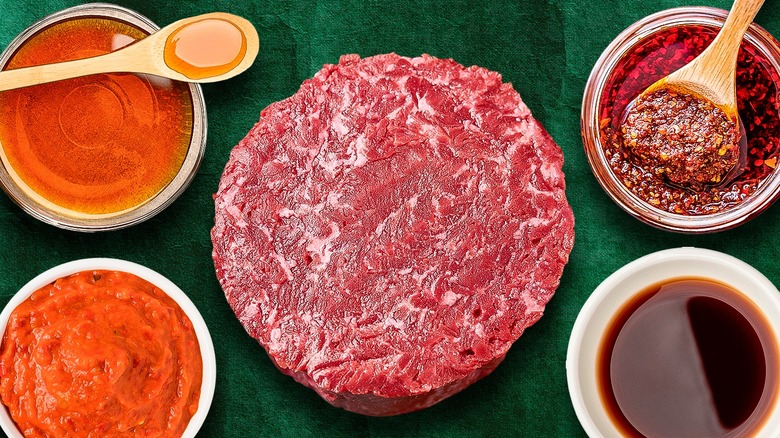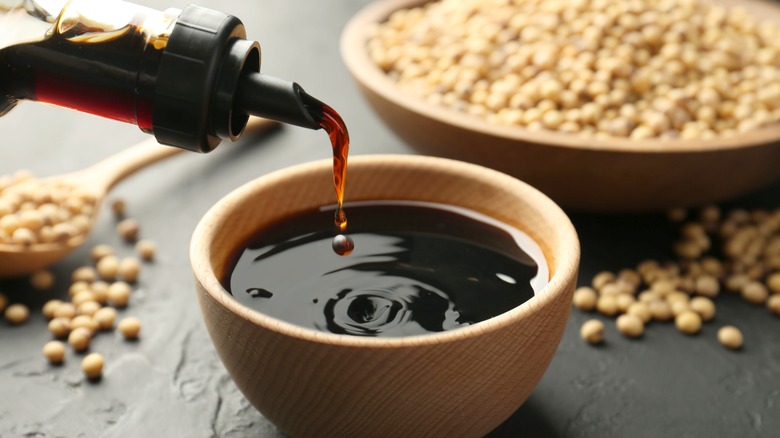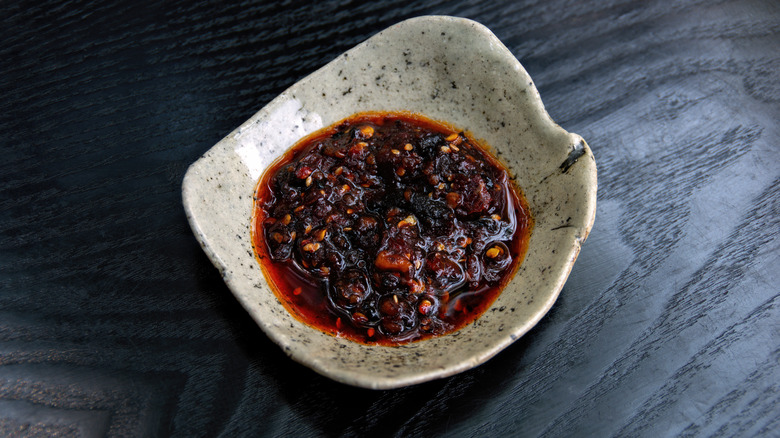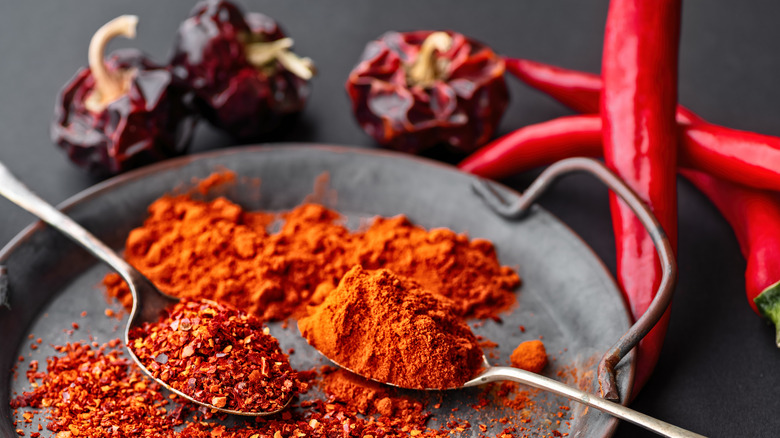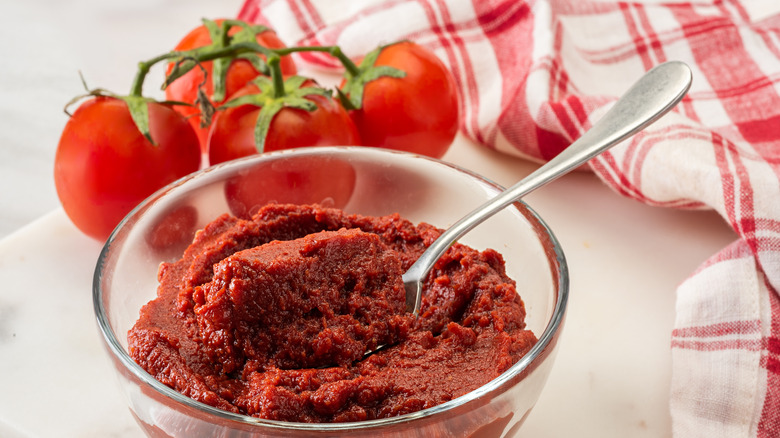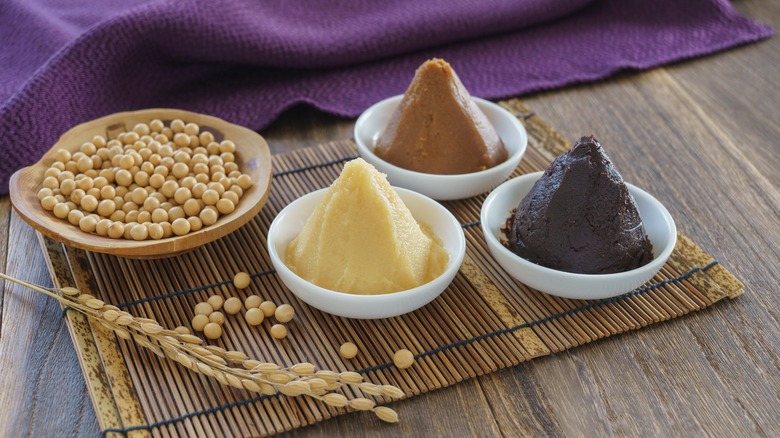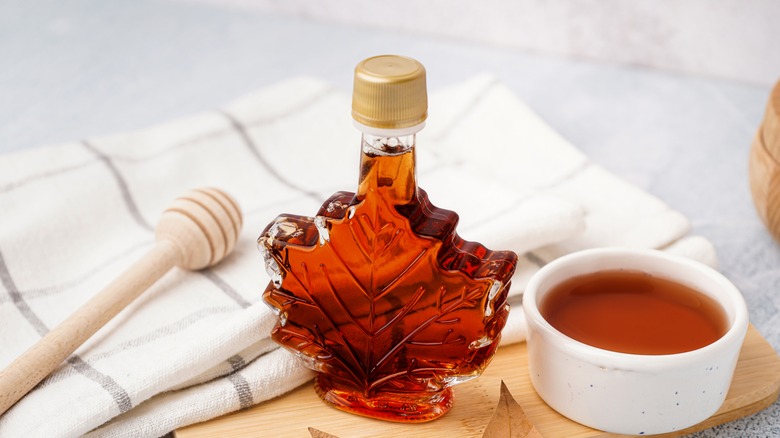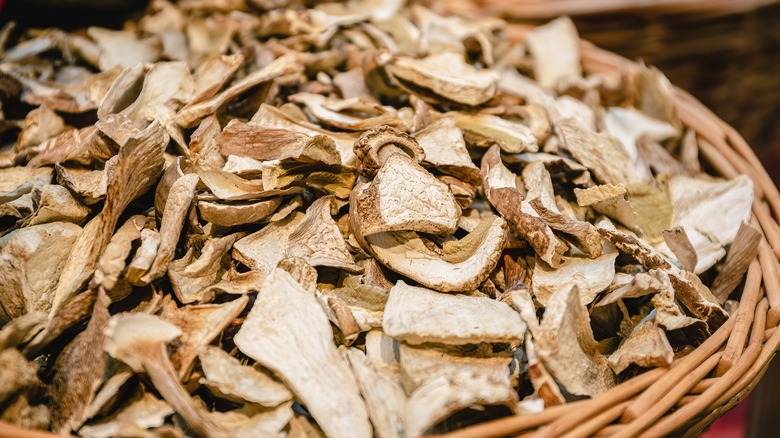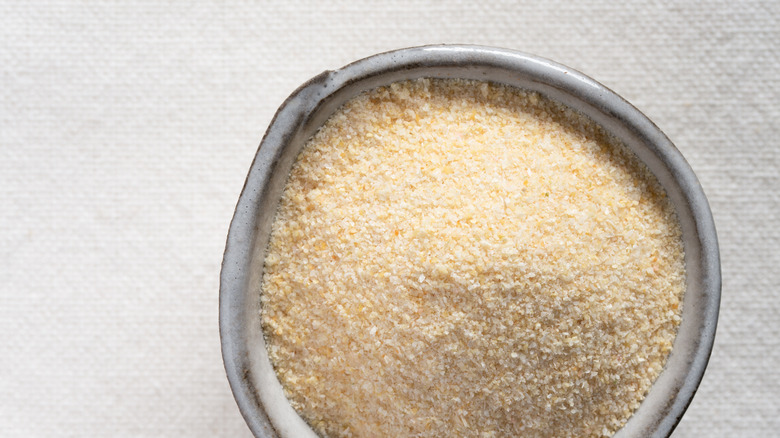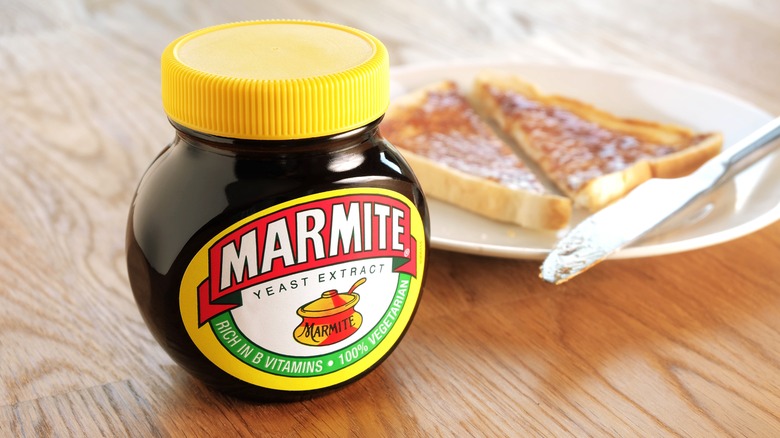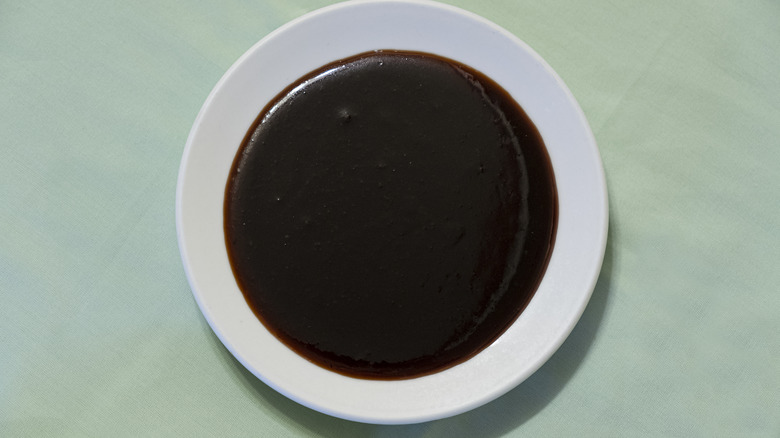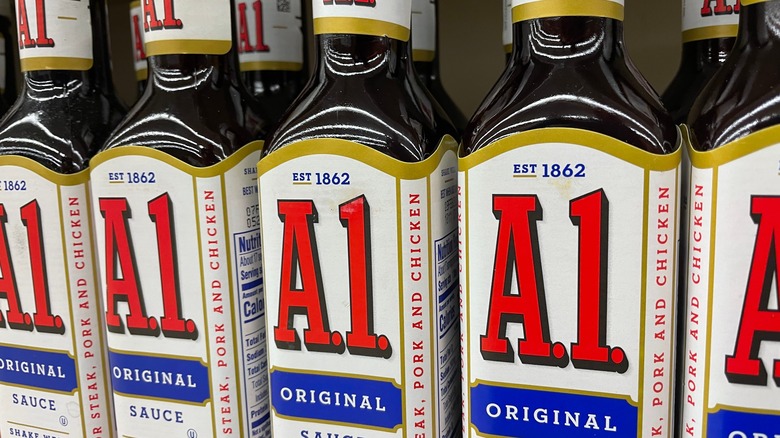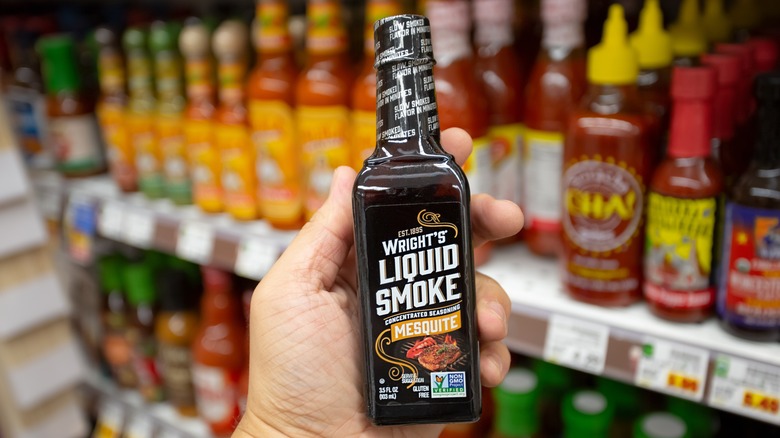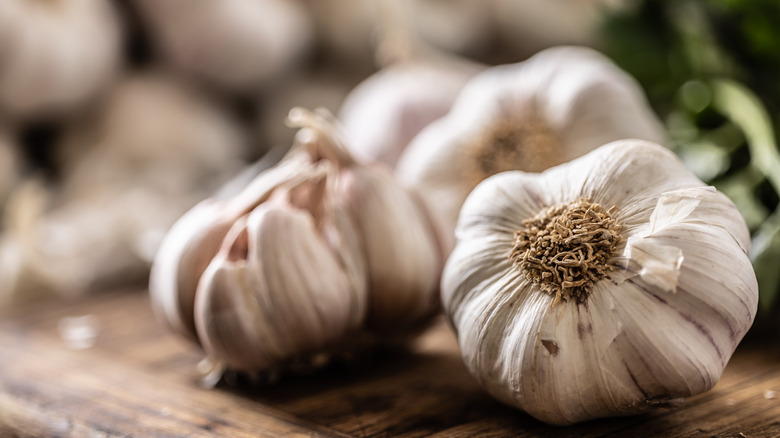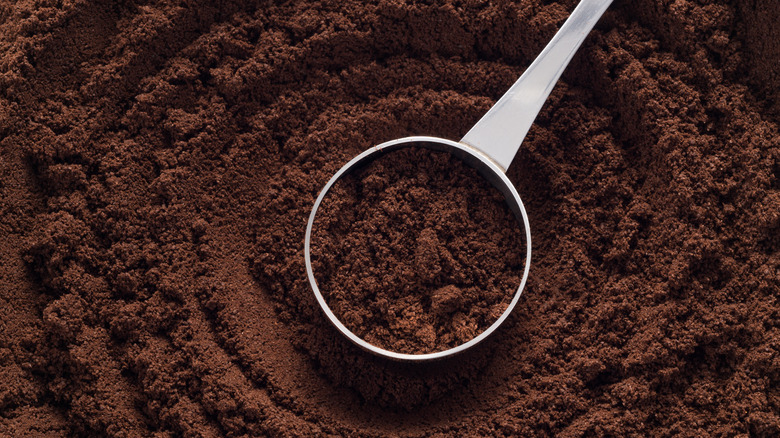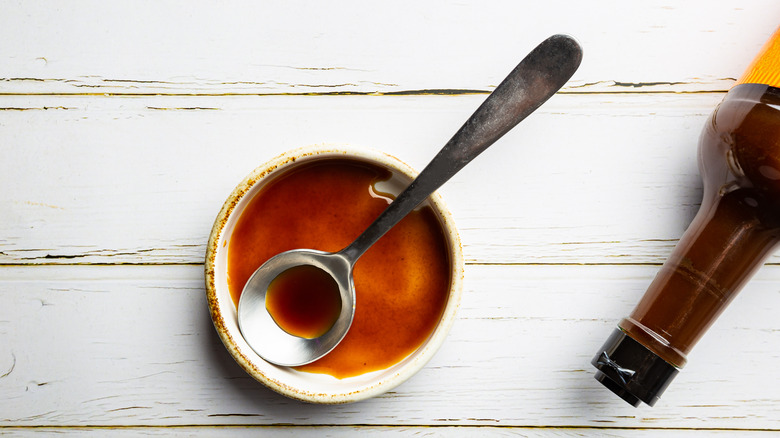15 Top-Notch Ingredients For A More Flavorful Vegan Steak
Although "vegan steak" might sound like an oxymoron, it's simply a way to expand our culinary horizons and challenge the meaning of steak. Why must we limit ourselves to bovine when the options for creativity are endless in the plant world? With that, it's important to note that any vegan version of steak will not taste like beef steak, but that's kind of the point. The undertones of flavor can vary immensely with this open concept of "steak," giving you access to endless textures and mouthfeels. Plenty of vegan ingredients can be made into meat alternatives, but as is true with most meats, it's all about how you flavor them. No mushrooms, eggplant, or cauliflower is going to pass as a steak unless sauced up with juicy, salty, fatty, savory flavors. Use top-notch ingredients for a more flavorful vegan steak, and you won't be disappointed.
As a plant-based chef and recipe designer, I like to focus on texture when selecting which vegetable or fruit you'd like to recruit for my vegan culinary endeavors. People miss that traditionally chewy or crispy texture that comes with meat. Cooking methods, seasonings, and sauces can alter the flavor. Typically, cauliflower, lion mane mushrooms, eggplants, tofu, vital wheat gluten, and butternut squash make an appearance, but there are plenty of fruits and vegetables that you can turn into vegan steak. Focus on adding a balance of sweet and savory notes, along with umami flavors and smokey undertones to help match the "steak" flavor profile.
Tamari and soy sauce
Perhaps one of the more top-notch ingredients for a more flavorful vegan steak is tamari or soy sauce. In fact, this is one of the best uses for tamari or soy sauce because they not only give your vegan steak that extra kick of salt, but the umami flavors are explosive. Umami and salty notes are slightly different. Although many umami-rich foods like soy sauce and miso are extremely salty, salt is not what makes it shine. Soy sauce achieves its flavor by a process in which the proteins are broken down by koji mold which turns it into amino acids.
As a plant-based chef, I strive to add umami when I can. Although some plant foods like asparagus, tomato paste, and mushrooms are rich in umami flavors, it's typically associated with a "meaty" flavor. When trying to recreate steak from plant foods it's a must. Add it to your marinade to flavor your plant-based meats. The combination of mushrooms and soy sauce is elite, so consider it next time you make a lion's mane mushroom steak, or a portobello mushroom "steak" tips. It also works well with sweeter vegetables like butternut squash or jackfruit.
Chili oil
Chili oil has found itself next to steak time and time again. It pairs well with steak and eggs but is also a wicked combination with steak and roasted garlic. When looking for ingredients to add to your vegan steak, it's important to keep in mind what ingredients might get called into play with a beef steak. This will help you mimic the flavors. And, who doesn't like a little heat? Chili oil usually contains chili flakes or crushed chilies, oil, salt, and typically a slew of aromatics like garlic, ginger, and spices.
These flavors marinate together to create a power-packed punch that will help shift focus from the steak being made from plants. Not a big fan of spice? That's okay. Use just a very little bit to excite the tastebuds without overwhelming them. It's an ingredient for many uses, which is why chili oil is the best meat marinade and spicy addition to keep in your pantry.
Smoked paprika
There are many different varieties of paprika, and all could be used in creating vegan steak. The main options to choose from are typically sweet, spicy, smoked, and Hungarian. I would recommend you choose smoked paprika for you vegan steak, to replicate that open-flame flavor of a classic grilled steak. Each variety is made from dried peppers, but there is a difference between regular paprika and smoked that takes place during the drying process. The peppers for smoked paprika are dried using a wood fire, which helps to infuse them with that naturally smokey flavor. After drying, the peppers are ground up to make the spice.
You can mix paprika right into a marinade, which would help to penetrate your vegetable with flavor, or you could sprinkle it on after it's cooked. When added to a marinade it may give your plant based steak a warm coloring which can be quite pleasing. However, refrain from sprinkling it on dry and then cooking your vegan steak in the oven or on the grill. Without moisture to protect it, it could burn and lose its flavor.
Tomato paste
Tomato paste is one of the easiest ways to add an umami boost to steak. Because tomatoes are high in glutamates, which are what give umami its unique taste, the concentrated version in the paste is the perfect addition to help vegetables take on that "meaty" flavor of steak. Tomato paste is a great option when working with more porous vegetables or soy products like tempeh or tofu. This is because of its dense mouthfeel and strong coloring that can penetrate through the layers of your vegan steak if marinated long enough.
Choose wisely when selecting tubed versus canned tomato paste for you vegan steak. Typically, the tubed version is from Italy, where they use a lower cooking temperature that can increase the sweetness of tomato paste. Often, the canned versions contain citric acid which can help to mellow the metallic flavors from the can, but often results in a slightly sour undertone. I recommend springing for the Italian-made tubed version for the most vibrant and clean flavor. And hey, it's also easier to store in your refrigerator. Use tomato paste with vegetables that won't be overpowered by its intensity, like eggplant or mushrooms.
Miso
It's okay if you only know about miso in the context of that savory and silky Japanese soup. You don't need to know everything about miso, but it's worth looking into if you want to step up your culinary game. It's salty, and made from fermented soy beans, but most importantly it is deeply savory. Miso paste is an absolute "must use" in vegan steak marinades because of this quality, but it's important to take note of how you incorporate it.
Miso does have a tendency to melt and burn. This makes it a great option for a glaze, but not so much for a marinade when you plan on searing your vegan steak. I like to use miso in my plant based steak sauce, which can be drizzled on the vegetable after it cooks. Balance the miso with a subtle sweetness, some spicy cracked black pepper, and herbs and spices to create a complete mouthfeel. It also pairs well with Dijon mustard, soy sauce, and brown sugar to bring that savory-sweet balance to your taste buds that we crave so deeply.
Maple syrup
Although we might not categorize meat as blatantly "sweet," it does have caramelized notes of sweetness when cooked. There are sugars present in meat, and when reduced over heat the flavor intensifies. Therefore, if you are trying to recreate the flavors of steak for your vegan venture, consider adding some sugar. Yes, vegetables do have sugar in them naturally, but your marinade should contain some too. Instead of using basic cane sugar, consider something with more flavor behind it. Vermonter's will tell you that maple syrup can be used in anything, and they are right.
Maple syrup is intensely sweet, but also has smokey notes, along with caramel, toffee-like undertones with a hint of vanilla. This will add richness to your vegan steak, along with smokey tones that mimic the sugars that caramelize in grilled meat. Now, this isn't dessert. So, you'll want to go easy on the maple syrup, including just a dribble to balance any acidity or heat. As the vegan steak cooks, this sticky syrup will cook with the other flavors of the marinade to create an irresistible flavor. For a more traditional sweetened steak, try maple bourbon steak tips, but of course, veganize them with sliced portobello steak or tempeh.
Dried porcini mushrooms
Now this addition might take a little bit of extra work and is a bit pricier but worth it in the long run. The best way to incorporate these power-packed mushrooms into your marinade is by grinding them up in a food processor until they are a fine powder. Be sure that they are totally dry at this point, or else they will be gummy and difficult to grind. Storing them in a cool, dry place will help to preserve them. Then, whisk that powder into your marinade and let the mushrooms do the rest.
I have selected porcini mushrooms because of their nutty and woodsy undertones that can almost be described as gamey. They often make an appearance in brown sauce and gravy, so if you have already selected your marinade there is still room to incorporate them in a sauce. The ground and dried porcini will have some texture to it, but this can enhance the steak-like quality of the dish. Even for beef steak, folks love to add mushroom sauce to expand on the already-present umami notes. In fact, porcini mushroom powder is key to an umami steak done right. Let's do it up veggie style.
Onion powder
Onion powder can add a layer of flavor to help round out a marinade, especially if you're using plants instead of meat as your base ingredient. This is why it is one of the best flavor boosts for a steak marinade, or especially for your vegan steak. Keep in mind that onion powder tends to have a flavor profile between raw onions and sweet cooked onions. It is more mild than granulated onion which tend to have more bite and intensity, and dried minced onions which are powerful in flavor and chewy in texture. I recommend onion powder for vegan steak over the other two options because it tends to be sweeter and has a smoother, more rounded mouthfeel.
Use it with almost any vegetable when transforming it into a steak. It can be a mild and buttery smooth addition to zucchini steaks, but also help to round the sweet flavors of a butternut squash steak. It's versatile, which is why it is one of the best flavor boosts for a steak marinade, especially for your vegan steak marinade.
Marmite
This love-it or hate-it condiment may be something you've never even heard of before. It was created using the yeast byproduct from brewing beer and is adored in England. Marmite is essential for every home pantry because it's quite versatile. It can be spread on toast or used to give a vegetable flavoring and umami boost to lentil shepherd pie or cashew cream macaroni and cheese. This is why marmite is elite when flavoring vegetables for vegan steak.
Like soy sauce or bouillon, marmite is extremely salty so should be used in moderation. In fact, you could omit using salt altogether in your vegan steak marinade if you choose to include marmite. Alternatively, I suggest serving it as condiment with your vegan steak to give it extra salt and pizzaz. A little smear should do the trick on any meaty vegetable like eggplant or cauliflower. Are you having trouble finding it in stores? Try ordering marmite online or going to a boutique market or English market.
Bachan's Japanese barbecue sauce
Once you've tried Bachan's Japanese barbecue sauce, there's no going back. For those new to Japanese barbecue sauce, there's nothing quite like it. It's not as sweet as teriyaki sauce but does have some similar qualities. It's much more savory and dense with flavor. It has plenty of aromatics to help it sing and is filled with deep umami notes. There are endless uses for Bachan's Japanese barbecue sauce, one of the best being to flavor a vegan steak.
Simply use it as a marinade to give your vegetable or handmade vegan steak intense flavoring. It mimics the depth of steak beautifully while completing all of the sweet and salty notes. Bachan's sells the sauce pre-made, so don't bother making it yourself. You can also use the sauce after your mushroom or vital wheat gluten has cooked up as a drizzle or glaze. The sauce does not need to be used in strictly Japanese cuisine, so enjoy it on your vegan Philly cheese steak, or on those mushroom steak tips.
A1 Sauce
If you used to be a meat and potatoes kind of person but have gone vegan or are experimenting with more plant-based foods then A1 sauce is going to be your best friend. It's important to keep your favorite marinades and sauces consistent while you transition to more veggie-centric foods. This will help you to skip the "this doesn't taste like beef" phase and help you to appreciate the vegetables and substitutions more. Luckily, A1 sauce is vegan.
Although A1 is usually associated with beef steak, it's accidentally made from all vegan ingredients. It has a tomato base and is loaded up with vinegar, raisin paste for sweetness, orange puree, and spices. This unique blend of flavors will help you associate your vegan steak with the beef version (while aligning with your diet and/or lifestyle). It's tangy, sweet, and savory, and should be used in both marinades and as a condiment for your vegan steak.
Liquid smoke
There's nothing like a barbecue in summertime. That smokey aroma that wafts off the grills and travels around the neighborhood is irreplaceable. Although it's often associated with meat, there is no reason that someone following a plant-based diet should give up grilling. Vegetables deserve to be grilled too, and they taste even more incredible with that smokey open flame. Use wood chips, or get creative by using some liquid smoke and omit the grill altogether.
Even if it's not grilling season you can still infuse that smokey aroma and flavor into your vegan steak. Liquid smoke is made using quite a process, but it all boils down to the captured essence from smoke, trapped by liquid and bottled for our culinary ventures. Liquid smoke often comes in different flavors depending on the wood used in the process, but we enjoy hickory or mesquite for vegan steak. Find it in the condiments aisle, or order some liquid smoke from Amazon.
Garlic
Now, anyone who enjoys cooking knows that the cornerstone of any good dish is garlic. Garlic is to cooking as vanilla is to baking: You just can't get enough of it. My favorite kitchen hack to enhance any dish is to use garlic powder. The powder can be used either in the marinade or can be sprinkled on after the steak has been cooked. Plus, it's easy to use with minimal cleanup.
Follow some basic tips you need when cooking with garlic to be sure you're getting the most from the bulbs. Roasted garlic is milder in flavor, but it's extremely creamy and sweet and makes for a good choice when paired with vegan steak. For a more intense flavor use minced or crushed garlic in your marinade. Crushed garlic works best because it helps the flavors to escape and seep into the vegetable without burning. Be sure to balance the subtle spice of garlic with some sweet enhancements like maple syrup or brown sugar.
Espresso powder
When making a dish that you hope to have a smokey, rich, and rustic flavor, spring for espresso powder or unsweetened cocoa powder. Both of these roasted beans have a beautiful intensity to them and can be used in anything from homemade chili to vegan steak. Whisk espresso powder into your marinade, which will also help to give it that meaty coloring and prevent it from burning over high heat. If you don't have espresso powder at home, you can substitute instant coffee.
Although this addition may seem unusual, it's that secret top-notch ingredient that gets used by top-tier chefs and home cooks. Your vegan steak will become so much more smokey and rich. It tends to hold up best with vegetables that have stronger flavors. Delicate vegetables like zucchini tend to get overpowered. Add it in moderation, as you don't want coffee to take over the flavor, as it should enhance not dominate. Let your plant-based steak marinate for long enough that the espresso can penetrate through the first layer and create flavor throughout. Just beware of eating too much right before bed if you're looking for a restful sleep.
Vegan Worcestershire sauce
Worcestershire sauce is one of those foods that seem vegan but isn't. Although it's typically made with anchovies, there are plant-based and vegan Worcestershire sauces out there. The fish-less version is rich in umami flavors, but much tangier than most soy-based sauces. When making your own vegan Worcestershire, swap the anchovies with meaty alternatives like miso or dried mushrooms. However, the main flavors come from the intensity of the soy sauce and vinegar.
The gluten-free version is made with tamari, sugar, garlic powder, spices, and plenty of vinegar. This is a great ingredient if you like your plant-based steak to have a zing to it, although be sure not to overwhelm the marinade with Worcestershire. Vinegar is typically a missing ingredient in cooking that creates a balanced mouthfeel. So including vegan Worcestershire sauce in your vegan steak marinade will bring it to the next level.
